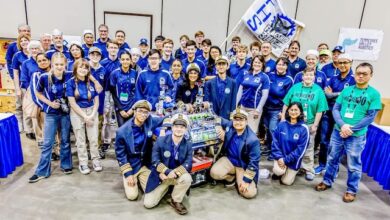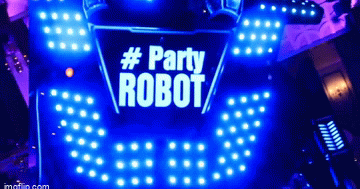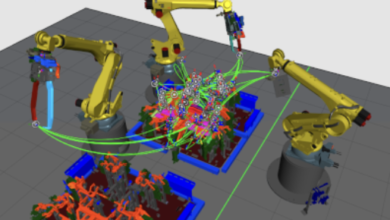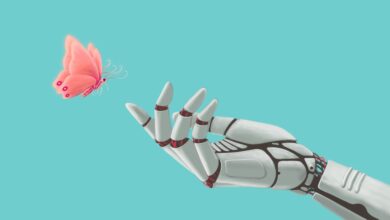USC Robotics Open House 2024 Inspires Next Generation Innovators – USC Viterbi
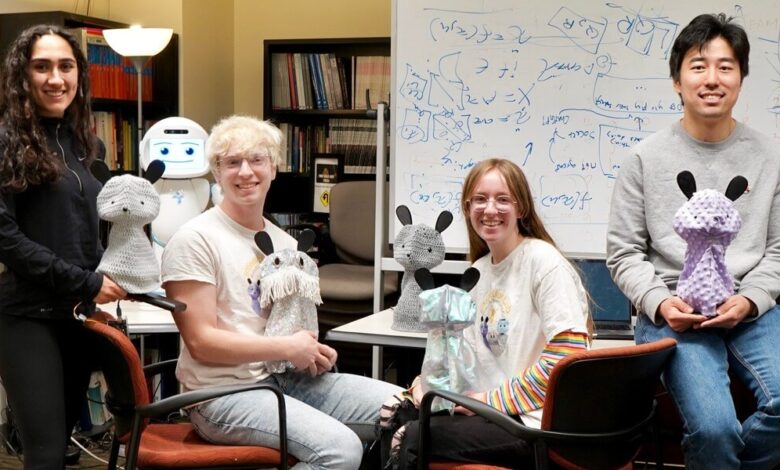
-
USC Viterbi Interaction Lab researchers showcase their robots
The pulsating heart of innovation beat loud and clear at the recent Robotics Open House 2024, where technological robotic marvels were showcased at the USC Viterbi School of Engineering.
The event, hosted by the USC Viterbi K-12 STEM Center, was a celebration of 2024 National Robotics Week, putting USC’s cutting-edge labs on display while igniting a fervor for robotics that reverberated through the minds of young and eager learners.
Picture this: nearly 170 students from all walks of life, their eyes wide with wonder, their minds primed for discovery, as they immersed themselves in a world where robots roam and innovation knows no bounds. This wasn’t just any open house; it was a gateway to the future, where the possibilities of robotics stretched as far as the imagination could reach.
“We are thrilled to have nine USC robotics labs participating in the open house this year,” said Katherine Guevara, USC Viterbi assistant director for the K-12 STEM Center.
“It is our goal to invite children from local communities to our campus, in hopes of sparking a lasting passion for STEM fields in them,” said Guevara. “We are also grateful for the labs for being open, welcoming and supportive of encouraging K-12 students to learn about robotics.”
This year marks the second time the event was hosted since the COVID-19 pandemic. The 2024 Robotics Open House saw an unprecedented level of interest once more, attracting nearly 200 attendees in total, consisted of 161 students, 25 teachers, and 23 Viterbi students who led the tours.
Notably, one special school participated for the first time: the Anawakalmekak School, Los Angeles County’s only and oldest autonomous Indigenous Peoples’ K-12 public community-based school. The school teaches in the Nahuatl (Mexihkatlahtolli) language and is part of the American Indian Science and Engineering Society.
Dynamic Robotics and Control Lab: traversing diverse terrains and assisting with complex human tasks
Among the stars of the show was the Dynamic Robotics and Control Laboratory, where Quan Nguyen, USC Viterbi assistant professor of aerospace and mechanical engineering and his team are redefining the possibilities of robotic agility.
The lab focuses on building extremely agile-legged robots through the development of control algorithms, which allow the robots to conduct and assist human tasks.
-

Dynamic Robotics and Control Lab Researcher Junheng Li tapping on the robot dog
Their crowning jewel, known as HECTOR (Humanoid for Enhanced Control and Open Source Research), sparked many students’ interest. HECTOR is a cost-friendly and accessible humanoid robot that Ph.D. student Junheng Li has been developing for the past two years. The current version of HECTOR can walk on different types of terrains, carrying up to eight kilograms payload and jumping over one foot gaps.
When asked about the next steps of HECTOR, Li said, “We want to make HECTOR a general embodied-AI platform that companies and schools can use for humanoid research to assist human tasks, such as delivering, warehousing logistics and rehabilitation.” Now, Li is trying to deliver the second version of HECTOR by May with optimized designs and upgraded features.
Another Ph.D. student in the lab, Yiyu Chen, focuses on developing quadruped robots that can adapt to various conditions. This robot was even more eye-catching because its appearance resembles a dog, and is referred to as a “robot dog” by the researchers in the lab.
So far, Chen’s robot has undergone testing in many different environments, including construction sites for inspection purposes and agricultural settings for basic task execution.
Looking forward, Li and Chen are adding more features to the robots, aiming to apply them to areas where HECTOR and the quadruped robots can assist with additional human tasks.
i-Lab: Bridging Worlds and Transforming Industries
Another innovative robot design on display at the event was created by the Innovation in Integrated Informatics LAB (i-LAB). Directed by Profesors Burçin Becerik-Gerber, Dean’s Professor of Civil and Environmental Engineering, and Environmental Engineering, and Lucio Soibelman, Fred Champion Chair in Engineering and Professor of Civil and Environmental Engineering, the lab prides itself in exploring human-robot interaction in construction.
-
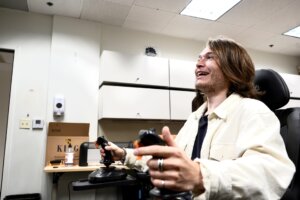
i-Lab researcher Antonin Brun playing with the 3D interface software
i-Lab’s signature research project was the sensory-enhanced teleoperation interface, where an operator uses joysticks and wears visual displays to remotely control demolition robots.
“The construction industry faces two major problems, one is the high number of fatal and non-fatal incidents, and another is labor shortages,” said Ph.D. student Patrick Borges Rodrigues, who is currently leading the teleoperation interface research.
To address these issues, the teleoperation interface emerges as a transformative tool that significantly reduces the risks humans face on construction sites, like collapsing floors and loud noises, which can often lead to injuries and hearing loss. Moreover, it expands employment opportunities in construction, making the field accessible to a broader demographic.
“Our goal is to use technology to turn physical work into an office job that more people can participate in. Especially young workers and women,” said Rodrigues.
Currently, Rodrigues is designing and testing the interface by partnering with various construction companies. In the future, he wishes to refine the interface’s features, enabling the machines to operate at elevated heights, ascend staircases, and perform more complex tasks.
Interaction Lab: Where Robots Embrace Compassion
Unlike the mechanical-appearance robots, the Interaction Lab presented some adorable robots on the day. Led by Maja Matarić, the Chan Soon-Shiong Chair and Distinguished Professor of Computer Science, Neuroscience and Pediatrics, the Interaction Lab dedicates itself to developing socially assistive robots designed to support health and behavior-related goals.
At the heart of the lab’s mission is to create robots that not only interact with individuals but also motivate and guide them through physical therapy exercises. Developed by the tech startup LuxAI, QT is a white, round, humanlike robot that helps patients do rehabilitation exercises. For example, QT plays a number guessing game, designed by Ph.D. Students Nathan Dennler and Catherine Yunis, where participants use thumbs-up and thumbs-down gestures to answer QT’s questions to practice using an assistive orthosis.
-
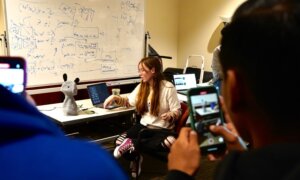
Interaction Lab researcher Amy O’Connell introducing the Blossom robot to students
As someone dedicated to community service since a young age, Dennler showed his passion and desire to help as many people as possible. “Robots don’t get tired or bored advising repetitive physical therapy tasks, so they can provide feedback and encouragement for as long as users want to keep using them,” said Dennler.
Besides QT, another robot stood out because of its cute, colorful look. Blossom, an animal-like robot covered in different colors of fabrics crocheted by Amy O’Connell, a USC Viterbi Ph.D. student in computer science, was designed as a study companion for students with ADHD.
Blossom’s subtle movements such as rocking side to side can help patients initiate and maintain focus during their study sessions, stressing the concept of “body doubling,” where the presence of another being enhances an individual’s ability to concentrate. O’Connell has tested Blossom in USC dorms and received feedback from students.
“Many students said they want to carry Blossom around, so we are trying to make Blossom a more mobile robot and develop a function where students can give instructions on their phone,” said O’Connell.
The Interaction Lab is currently collaborating with the USC Health Sciences Campus and Children’s Hospital Los Angeles. These partnerships are pivotal in recruiting participants for the lab’s studies and research, particularly in providing access to marginalized populations such as ADHD and stroke patients.
As the event drew to a close, one thing became abundantly clear: the future belongs to those who dare to dream. With a spike in the number of attendees since the pandemic and a diverse array of participants, the open house stood as a testament to the power of inclusion in shaping the next generation of innovators.
With more than 20 programs a year and a commitment to diversity, equity and inclusion, the K-12 STEM Center is poised to ignite a passion for STEM that knows no bounds. For more information on upcoming events, please visit their website here.
Published on April 17th, 2024
Last updated on April 18th, 2024
